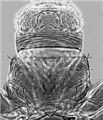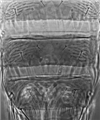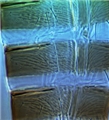Thrips tabaci
Recognition data
Distinguishing features
Both sexes fully winged. Body size and color variable depending on temperature during development, from small and whitish yellow to large and brown; ocellar pigment usually grey, never red; forewings pale. Head wider than long; with two pairs of ocellar setae; pair III small, arising on anterior margins or just within ocellar triangle; postocular setae pairs I � III about equal to ocellar setae III. Antennae 7-segmented; segments III � IV with short forked sensorium; VII short. Pronotum with two pairs of prominent posteroangular setae; posterior margin with three (sometimes four) pairs of setae. Metanotum variable, usually irregularly reticulate medially with lines converging to midpoint at posterior margin; median setae short, arising behind anterior margin; campaniform sensilla absent. Forewing first vein usually with four (varying uncommonly from two to six) setae on distal half; second vein with about 15 setae. Abdominal tergite II with three lateral marginal setae; V � VIII with paired ctenidia, on VIII posteromesad to spiracles; tergite VIII posteromarginal comb complete, microtrichia long and slender; pleurotergites without discal setae, with closely spaced rows of fine microtrichia. Sternite II with two pairs of marginal setae, III � VII with three pairs; sternites without discal setae. Male (rare in most populations) small and yellow; tergite VIII with marginal comb represented by few irregular microtrichia; sternites III � V with narrow transverse glandular area.
Variation
Adult females vary greatly in size and color, from small and yellow to large and dark brown.
Related and similar species
The genus Thrips is the second largest genus in the Thysanoptera, and currently includes, worldwide, about 280 species. T. tabaci is unusual within the genus in lacking red pigment around the ocelli, and is usually easily recognized by the closely spaced rows of microtrichia on the pleurotergites. All members of genus Thrips lack ocellar setae I on the head, and they all have ctenidia on tergite VIII posteromesad to the spiracles. Other characters, such as number of antennal segments, number of setae on the forewing veins, and number of discal setae on the sternites are variable between species (Palmer, 1992; Nakahara, 1994; Mound & Masumoto, 2005).
Taxonomic data
Current valid name
Thrips tabaci Lindeman
Original name and synonyms
Thrips tabaci Lindeman, 1889: 61
Limothrips allii Gillette, 1893: 15
Thrips communis Uzel, 1895: 176
Thrips annulicornis Uzel, 1895: 177
Thrips pulla Uzel, 1895: 177
Thrips obsoleta Uzel. 1895: 187
Thrips bremnerii Moulton, 1907: 59
Parathrips uzeli Karny, 1907: 48
Thrips bicolor Karny, 1907: 49
Thrips brachycephalus Enderlein, 1909: 441
Thrips hololeucus Bagnall, 1914: 24
Thrips adamsoni Bagnall, 1923: 58
Thrips debilis Bagnall, 1923: 60
Thrips mariae Cotte, 1924: 2
Thrips frankeniae Bagnall, 1926: 654
Thrips seminiveus Girault, 1926: 1
Thrips tabaci f. irrorata Priesner, 1927: 436
Thrips tabaci f. atricornis Priesner, 1927: 437
Thrips tabaci f. nigricornis Priesner, 1927: 436
Thrips dorsalis Bagnall, 1927: 576
Thrips shakespearei Girault, 1927: 1
Thrips indigenus Girault, 1929: 29
Thrips dianthi Moulton, 1936: 104
Ramaswamiahiella kallarensis Ananthakrishnan, 1960: 564
Family placement
Thripidae, Thripinae
Common names
Onion thrips
Biological data
Life history
Breeding on leaves and in flowers, also predatory as larvae and adults. Males are usually rare (Nault et al., 2006), but have been studied in good numbers from eastern Mediterranean countries and also from New Zealand.
Host plants
Although particularly abundant on onions, this species is highly polyphagous, breeding on many hosts including monocotyledonous and dicotyledonous plants.
Tospoviruses vectored
TSWV
Crop damage
Particularly important on onions and garlic, but also on Brassica and tobacco crops in parts of Europe, and on various other crops including potatoes and greenhouse plants in different parts of the world.
Distribution data
Area of origin
Presumably eastern Mediterranean
Distribution
Cosmopolitan except for wet tropics.





